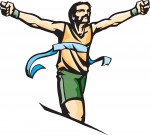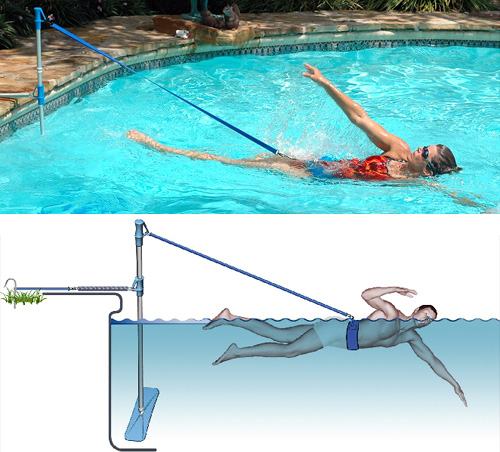
As astonishing as Usain Bolt’s record-breaking 100-meter sprint was, his time of 9.69 seconds is nowhere near what biostatisticians predict is the natural limit for the human body.
But because he broke the mathematical model that had fit 100-meter record data for almost a century, Bolt’s incredible performance could reset how fast researchers believe humans ultimately can run.
"This trend seems to defy simple curve fitting," wrote Tatsuo Tabata, director of the Institute for Data Evaluation and Analysis in Japan.
Statisticians have used a lower limit for 100-meter times of about 9.45 seconds, according to Tabata and other researchers. The exponential curve seen above — which is drawn from an equation calculated to fit the world record data — had been quite successful at predicting the steady progress of faster and faster 100-meter times. But Bolt’s recent string of world records was
clearly not an expected event: The model didn’t predict a
9.69 until almost 2030.
Though no statistician we spoke with had recalculated their numbers, the new world record is likely to rejigger the equations they use to calculate the maximum human speed. Â
"With this new data, [the predicted fastest 100-meter time] would probably go down a little bit," said Reza Noubary, a mathematician at Bloomsburg University of Pennsylvania and author of a textbook on statistics and sports. He had previously calculated an "ultimate record" of 9.44 seconds for the 100 meter.
Mathematicians like Noubary don’t use the body’s physiology to assess human physical limits. They were merely working with data that suggested that human speed increases were decelerating and would eventually stop completely. Indeed, in some events, like the long jump, the pace of record-setting has slowed nearly to a stop. That record has only been broken twice since 1968.
But it could just be that mathematicians have been modeling the pace of progress wrong all along.
Several years ago, Jonas Mureika, a physicist at Loyola
Marymount University in Los Angeles, developed a model using techniques drawn from seismology that
predicted a Bolt-like time by 2009. But, he didn’t believe his own
numbers and decided not to publish the work.
"The record then was about 9.79 and [the model] predicted these crazy
times, that by 2009 it'd be down in the high 9.6s," Mureika said. "I
thought that's crazy, it's not going to progress that fast. Every day
that I think about that, I kick myself. That's my penitence for
doubting the numbers."
Despite the success of Mureika’s model, Peter Weyand, a physiologist at Southern Methodist University in Dallas who focuses on the biomechanics of running, said that mathematical
models could never predict how fast humans might eventually run.
"Predicting it is fine for the sake of kicks, but it's not a
scientifically valid approach," Weyand said. "You have to assume that
everything that has happened in the past will continue in the future."Â
He suggested that it’s impossible for mathematicians to predict the
magnitude of the freakiness of athletic talent at the extreme margins
of humanity. Bolt, it turns out, is a perfect example.
Weyand, who has conducted research on the body types of the top 45 100-meter sprinters
in the last 15 years, said that almost all elite runners conform to the
body norms for their race length, except for the most-recent Olympic
champion.
"Bolt is an outlier. He's enormous," Weyand said. "Typically when you get someone that big, they can't start."
That’s because muscle speed in animals is generally tied to
their size. For example, rodents, being much smaller than
elephants, can move their muscles much faster. The
same holds true for human beings. Sprinters are short and have more
fast-twitch muscle fibers, allowing them to accelerate quickly, but
compromising their ability to run longer distances. Four hundred-meter runners,
almost always taller, have the reverse composition of muscle fibers.
Bolt, though, combines the mechanical advantages of taller men’s bodies with the fast-twitch fibers of smaller men.
"We don't really know what the best form is and maybe Bolt is redefining that and showing us we missed something," said biomechanicist John Hutchinson of the Royal Veterinary College at the University of London, who studies how animals move.Â
Hutchinson also agreed with Weyand that the human speed limit will remain impossible to predict with any confidence.
For him, it’s the International Olympic Committee and other regulatory
authorities that will determine how fast athletes will be able to run
by limiting the amount of advanced biotechnologies sprinters can use.
"The limits will be largely set by the rules of the IOC," Hutchinson
said. "It's kind of an arms race with the regulators of the sport and
the people trying to push the technology to the limits. At some point
here there must be a détente where technology can't push us any further
and the rules will restrict it."
With techniques for gene therapy likely to become available at some
point in the not-too-distant future, Weyand said that its use by
athletes was "inevitable."
"You could see really freakish things and we probably will," he warned.
See Also:
WiSci 2.0: Alexis Madrigal’s Twitter , Google Reader feed, and webpage; Wired Science on Facebook.
 Edison Pena, one of the Chilean miners who was trapped underground for 69 days, was known to the media as “the runner†because he ran long distances underground to keep physically fit. On Sunday, he’s going to compete in the New York City Marathon, according to Mary Wittenberg, the President of the New York City Road Runners Club:
Edison Pena, one of the Chilean miners who was trapped underground for 69 days, was known to the media as “the runner†because he ran long distances underground to keep physically fit. On Sunday, he’s going to compete in the New York City Marathon, according to Mary Wittenberg, the President of the New York City Road Runners Club:








